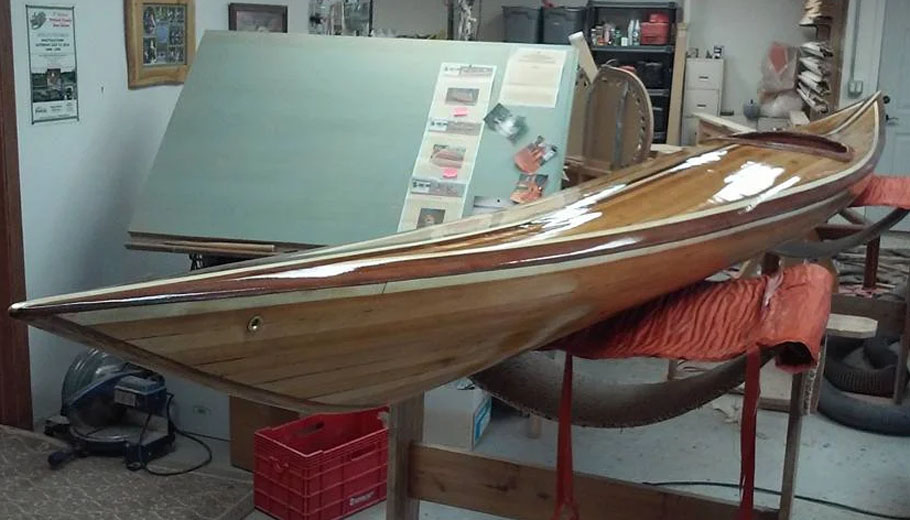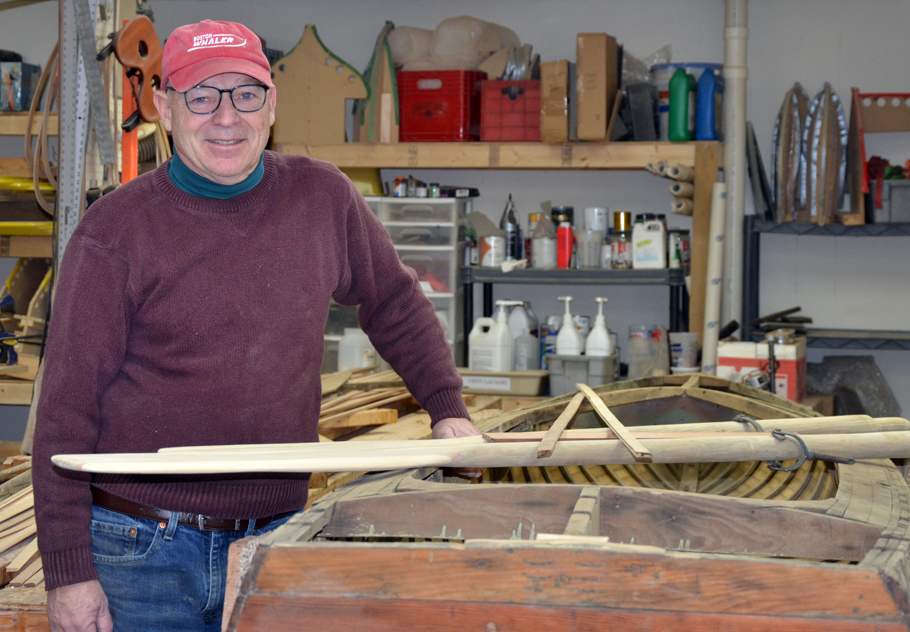
Craftsman builds award-winning boats
By James Card
Bob Buss has only one more cedar-strip kayak to make and then he is in the clear.
Noah, his fourth grandchild, received a kayak this Christmas. So far all of his five grandchildren have been given a kayak that he has made himself. For his two adult children, he promised each of them a kayak as a wedding present.
The last grandchild is still too young to paddle but Buss has plenty to do in the meantime as the sole proprietor and craftsman of Waupaca Boat Works.
He retired from R&L Carrier last May so now he has more free time to devote to his craft. Currently in his workshop are a stand-up paddleboard under construction and an old wooden duck hunting skiff that he will be restoring.
Earlier this summer, he finished a kayak for Barry Tomaras, former owner of Waupaca Area Ambulance.
Last year, Buss won the best non-powered wood boat award at the Minocqua Antique and Classic Boat Show.
Birdhouses to boats
Buss built his first boat in 2005 with a Nipmuc canoe kit from Newfound Woodworks.
“My daughter turned 18, got engaged, and I had to follow through for the wedding present. Before that I was just making bird houses,” he said.
The kit came with pre-cut cedar strips and the forms are pre-made. The wooden box that was shipped in doubled as a strongback, which is like a spinal cord for mounting the forms. He built it in three months.
Buss enjoyed it so much that he’s made two boats per year ever since for the past 18 years.
He graduated from the kit boats to cutting the cedar strips himself from cedar deck boards. The strips are 16 to 18 feet long and he rips them into one-inch strips on a table saw. They are a quarter-inch thick and he routers them to make a cove and bead edge so they fit together without a gap when glued together.
After that is one layer fiberglass cloth on the outside and the inside. “That is the structure of the boat. It holds all these strips together, makes it waterproof and adds a lot of strength,” he said.
Buss uses MAS epoxy, a brand that he prefers since it leaves little odor. His workshop is in his basement and he doesn’t want that strong chemical odor permeating the house. He also says it bonds better with the fiberglass when sanding as the dust isn’t itchy.
His canoes, kayaks and rowboats are priced from $7,500 to $9,500 and take approximately 20 weeks to build.
“People say they are too nice to use. Oh, no. That’s the best part. Get them out there in the water and have fun with them. You’ll get a lot of compliments out on the water with them,” said Buss.

Schooled in rowboats
To learn about rowboats, Buss received instruction from Lawrence University’s rowing team.
“I love rowing and I always through it would be cool to have one of those old wooden rowboats but nobody is making them anymore and nobody is making the oars,” Bus said. “So I did.”
The rowboats are not the boxy boats most people think of. They are sleek rowing shells, more canoe-like and one he made is only 20 inches wide.
With modern rowing shells, the oarsmen use carbon fiber oars. Buss thought that would look out of place on a wooden shell so he taught himself to build the ultra lightweight wooden hollow oars that were used in the past and are now longer made.
“I tried putting an outboard motor on the first one, most of that boat was way out of the water,” he said as he lifted his hand to the ceiling. “Man, that was the tipsiest boat I’ve ever had in my whole life. That’s why they made rowboats wider—to support all that weight and that’s why people don’t enjoy rowing anymore because the boats are not efficient for rowing.”
Paddleboard experiment
“I’ve gotten a lot requests from people that wanted wooden stand-up paddle board,” he said.
Buss noted that most commercially made wood paddleboards are nothing more than a slab of foam with a wood veneer so he set out to built one entirely from wood.
Similar to building his canoes and kayaks, Buss uses cedar strips that are laid over mahogany plywood ribs to create a hollow inside and like his kayaks, it gets a fiberglass and epoxy finish. There was one problem that occurred to him: if water gets inside, how can it get back out? He added an air differential plug that allows air out but no water in.
The problem is the paddleboard warming in the sun and then being put in cold water. The expanding and contracting of the temperatures causing cracking and water gets in. He built and sold a paddleboard to a man that used it all summer long. Water got inside and it was ruined.
“We brought it over and it was soaked inside. Pretty much ruined. I gave him a total refund. So now I’m not building them for people to use. If they want to use them, they can, but it’s out of my control,” said Buss.
He salvaged the board, refinished it and later sold it for display only.
Paddling around Waupaca
He and his wife lived in Neenah and were involved in the Boys Brigade at Camp Onaway. They ran the canoe club for several years and took kids on canoeing trips to provincial parks in Canada.
“We spent almost every weekend here in Waupaca, either at Camp Onaway or hanging out on the Chain or going to Hartman’s Creek. My wife and I thought if we’re going to retire and build a house, let’s do it here in Waupaca where we love being anyways,” said Buss.
His boats are made locally and used locally.
“You can really stretch your paddling legs. You can start out at the boat landing on Taylor Lake and paddle all the way to Whispering Pines and you’ll have to walk your canoe through Beasley Creek. It’s a nice day paddle. The water is crystal clear and you can get out and go for a swim. It just doesn’t get any better,” he said.
For more information, go to www.waupacaboatworks.com/
